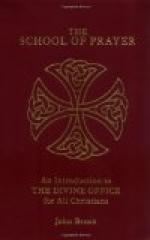The present verse divisions of the Vulgate were introduced by a Calvinistic printer of Geneva, who used them in an edition of the Greek new Testament published in 1561. Formerly, biblical chapters were, for sake of reference, divided into seven sections denoted by letters of the alphabet a, b, c, etc. In the older breviaries, the reference to the little lesson at Compline stood, I. Pet. v.c. The new Breviary has adopted the modern form of reference, and we now read I. Pet. v. 8-9. It is sometimes confusing to find reference made to the psalms by non-Catholic writers. This arises from the different method of numbering which is used by them. In the Greek version of the old Testament—the septuagent—the Psalter is arranged differently from the Hebrew. Psalms 9 and 10 are counted as one and so are Psalms 114 and 115, but 116 and 117 are divided into two, leaving the complete number 150, as in the Hebrew version. The Vulgate and the Douay version follow the Greek, and Psalm 9 contains 21 verses, not 38 as in the English Authorised Version. The English revised version follows the numbering of the Vulgate.
“Our Latin version of the Psalms is that of the old Itala; it was not made directly on the Hebrew original ... it is then a translation (the Greek). By the time of St. Jerome, it had become very faulty, owing to the very many transcriptions which had been made of it; and this great scholar revised it, about 383 A.D., on the request of Pope Damascus. His corrections were not very numerous, because, he feared to upset, by too many changes, the habits of the faithful, most of whom knew the psalms by heart. This first version is known as the Roman Psalter. It was soon deemed insufficient. St. Jerome once more set to work between 387 and 391, and published a second edition, more carefully and more extensively corrected, of the Italic version of the Psalms; it is called the Gallican Psalter, because it was adopted by the churches of Gaul. When he, later on, translated the Old Testament from the Hebrew, he published his third edition of the Psalms, the Hebraic Psalter. This version was a good one, but the faithful were so familiar with the old Itala psalter that the Church, in her wisdom, thought best to keep it in the editions of the Vulgate according to the Gallican form.... Our official version of the psalms is then in many ways defective. It is frequently incorrect and barbarous in style, obscure in places, and even fails at times to give the exact sense of the original. Although our Vulgate is not perfect, it possesses admirable strength and conciseness, joined to an agreeable savour which gives it the greatest value and causes the words of the sacred singers, under this form of the Latin spoken by the people, to strike the mind and become engraved upon the memory much better than if they were clothed in all the elegance of a modern tongue” (Vigouroux; Manuel Biblique, tom. ii., 663-664).




